r e a: maang (message stick)
Artist(s):
Collaborators:
- Christine Nicholls
- Gail Kelly
- Stephen Jones
-
- DreamWorks Pictures
- Peter Oldham
Title:
- maang (message stick)
Exhibition:
Creation Year:
- 2007
Medium:
- A three-channel video with sound on DVD triptych (10 min-loop)
Category:
Artist Statement:
r e a is a new-media artist who works in photography, digital media, moving images, and creative environments. She is a descendent from the Gamilaraay/Wailwan people, born in Coonabarabran, New South Wales, and now living in Sydney. She has a MSc in Digital Imaging and Design from the Centre for Advanced Digital Applications (CADA), New York University (2004); MA (Visual Arts) Australian National University,
Canberra (2000); and a Bachelor of Fine Arts (Visual Arts) from the College of Fine Arts, University of New South Wales (1994). In 2006, she received a New Media Arts Fellowship from the Australia Council for the Arts, which allowed her to return to New York City to participate in the Live-I Workshops presented by Troika Ranch Contemporary Dance Company. Her new video triptych, maang, was shown in the Auckland Triennial – Turbulence 2007. In maang, r e a has directed her attention away from her own inland home. The setting is La Pérouse, a coastal site on the southern shore of Sydney at Botany Bay. Named after the French navigator who landed there on 26 January 1788, La Pérouse is a place of immense significance for Indigenous Australians. In 1855, La Pérouse became an Aboriginal reserve that even today has a large Indigenous population, many of whom comprise part of the broader Indigenous diaspora from regional Australia to the cities. One needs to probe beneath maang’s sheer visual beauty and its poetic lyricism to find a way into the work’s deeper concerns, particularly the tumultuous impact of colonization on Indigenous Australians, which is still distorting identities and destroying languages.
Importantly, maang is not only about loss of land and language, and the turbulent times following colonization, but also about the possibility of renaissance, revitalization, and regeneration of people, land, language, and culture. As r e a observes: “I lost access to my mother tongue as a result of colonization. My great grandparents from both parents’ sides spoke their own languages. From my grandparents’ generation through to my generation we did not learn to speak our language fluently.”






